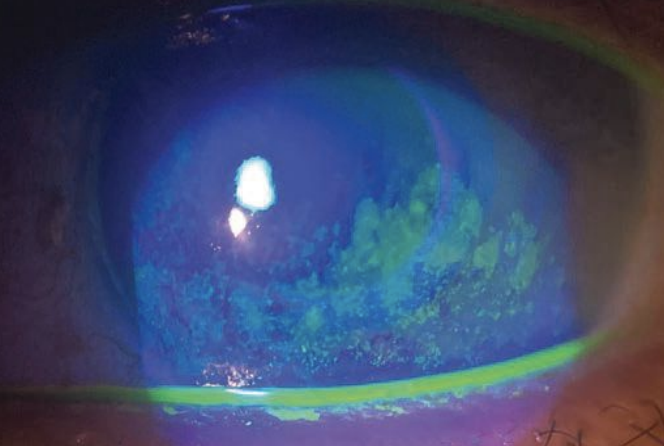 |
Dry eye is a possible newly emerging side effect of endocrine therapy for breast cancer. Photo: Pam Theriot, OD. Click image to enlarge. |
Side effects such as fatigue, joint pain and stiffness are common in endocrine therapy to treat breast cancer. The authors of a recent study presented at ARVO in New Orleans researched another possible side effect of this treatment: dry eye. They investigated the frequency of dry eye, its clinical subtypes and risk factors among breast cancer patients undergoing endocrine therapy, including selective estrogen receptor modulator and aromatase inhibitors, and they found high percentages of dry eye in these patients.
A total of 88 women were included—56 women undergoing aromatase inhibitors treatment and 32 undergoing selective estrogen receptor modulator treatment. Their age, BMI, treatment situation and ocular symptoms were recorded. A Comprehensive Eye Surface Detector was applied to detect patients’ ocular surface condition and evaluate for signs of dry eye. Self-Rating Anxiety Scale and Hamilton Anxiety Scale were administered to evaluate patients’ anxiety and depression, and levels of blood lipid and sex hormone were also examined. Various analyses were conducted to determine the frequency of dry eye, its clinical subtypes and associated factors.
Seventy-seven, or 87.5%, of the breast cancer patients had dry eye. Among this group, 11.4% received selective estrogen receptor modulator treatment and 76.1% received aromatase inhibitors. The frequencies of the clinical subtypes of dry eye were evaporative dry eye (59.7%), aqueous-deficient dry eye (23.4%) and mixed dry eye (16.9%).
Among aromatase inhibitor-treated patients with dry eye, patients under the age of 50 had significantly more prevalent subjective symptoms and objective exam results of dry eye than those of patients older than 50. All breast cancer patients had different degrees of anxiety and depression, the prevalences of which were significantly higher than patients without dry eye. The degree of anxiety and depression was related to the severity of dry eye; the higher the degree of dry eye, the higher the degree of anxiety and depression. Age, BMI, lipid profile and sex hormone level were found to not be significantly associated with dry eye.
“Taking measures to intervene in the occurrence and development of dry eye at the initial stage of endocrine treatment for breast cancer patients may greatly improve the patients’ quality of life,” the authors concluded in their abstract.
Original abstract content © Association for Research in Vision and Ophthalmology 2023.
Ma N, Zhang C, Zhao H. Dry eye, its clinical subtypes and associated factors in breast cancer patients undergoing endocrine therapy: a cross-sectional study. ARVO 2023 annual meeting. |


